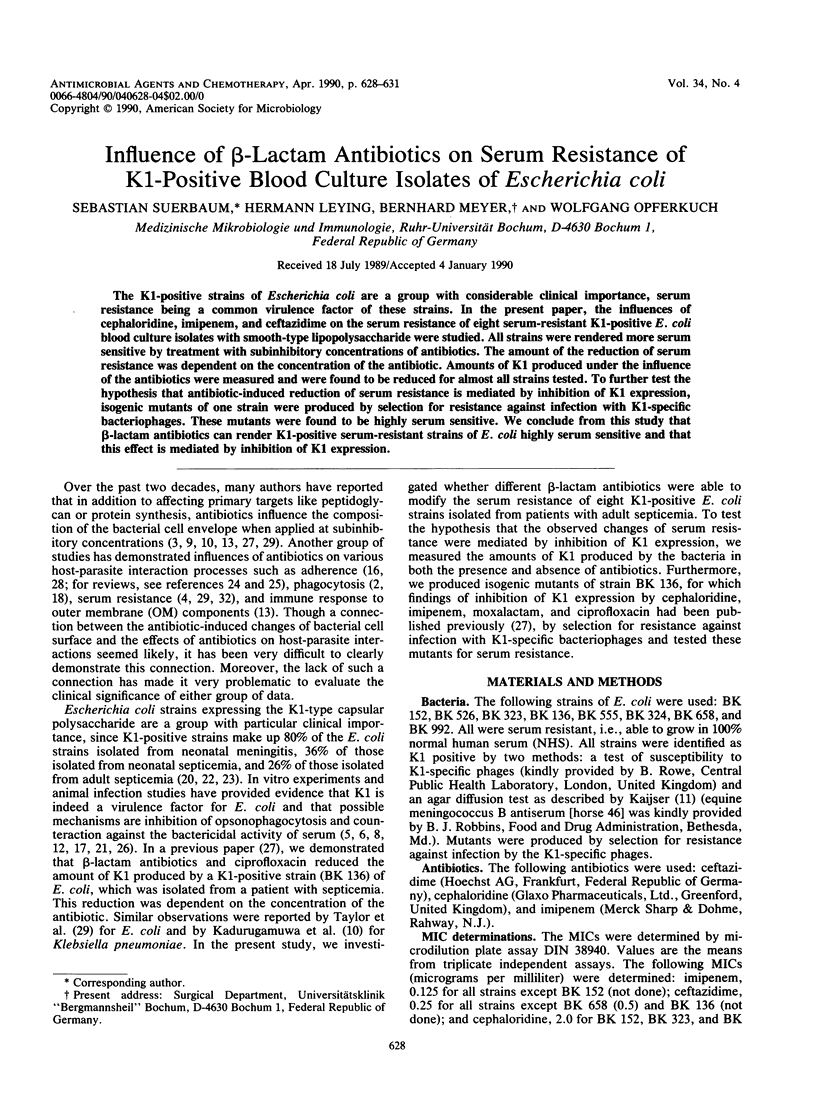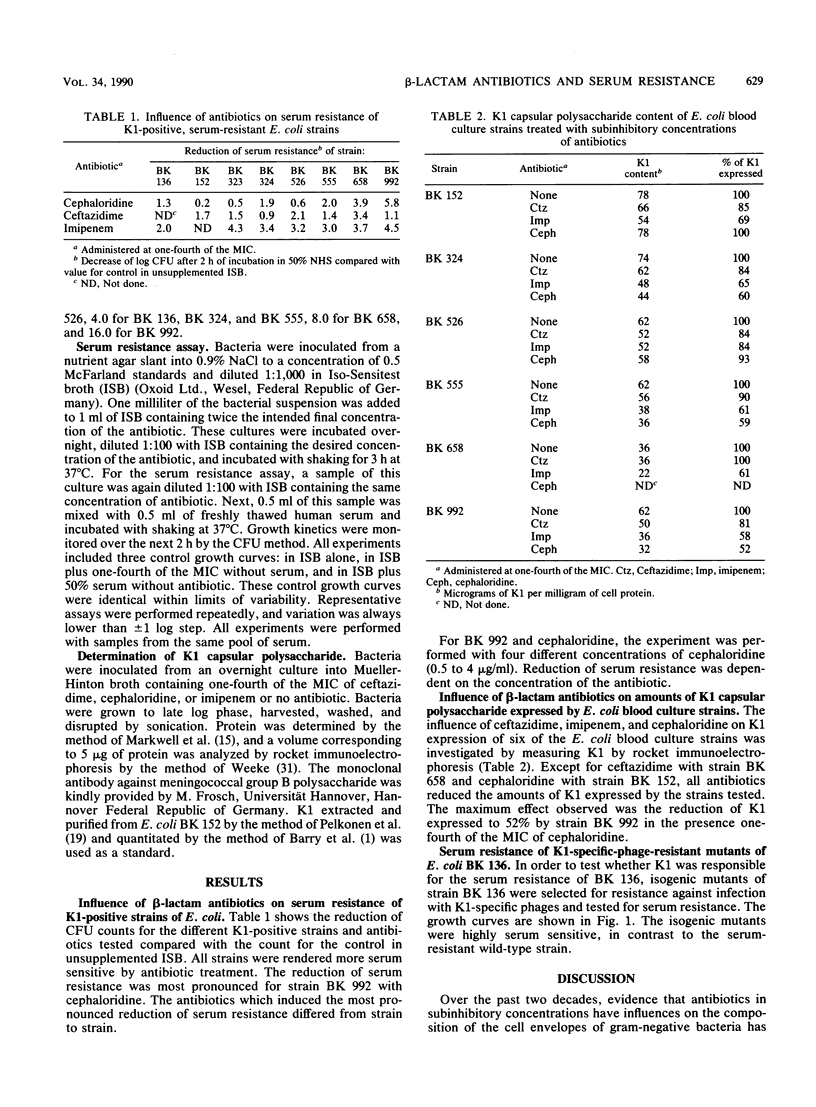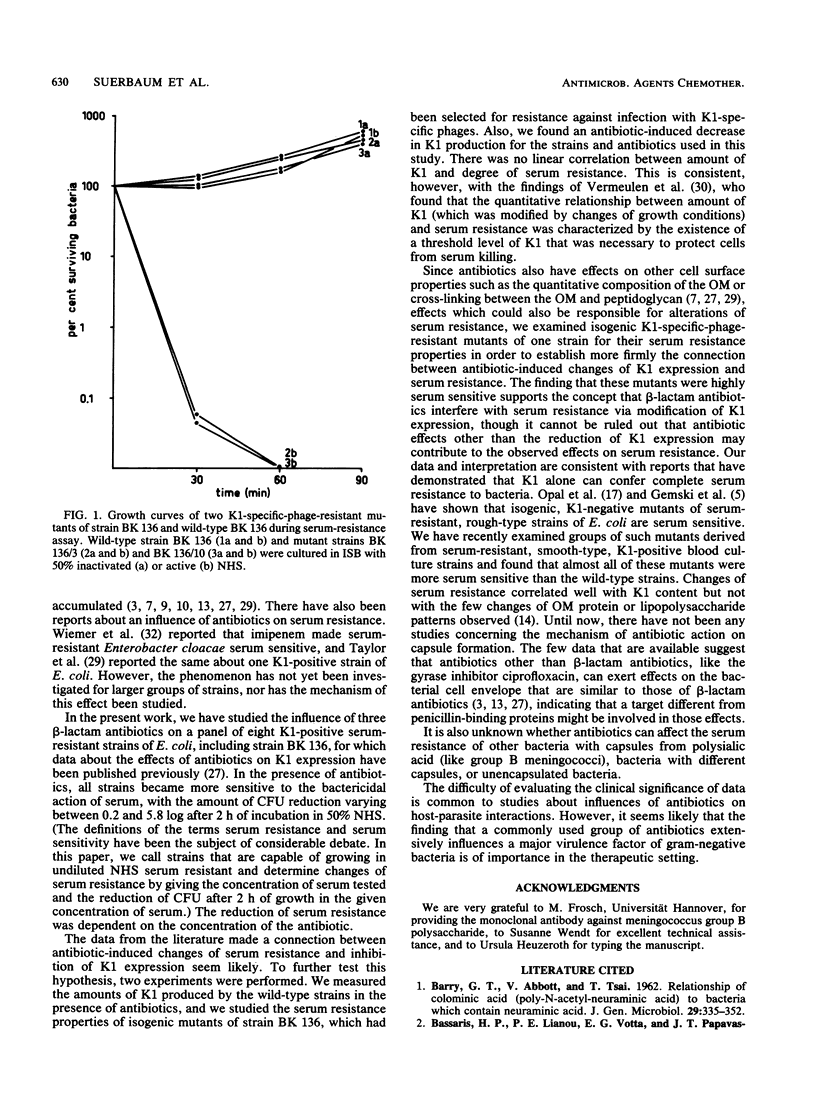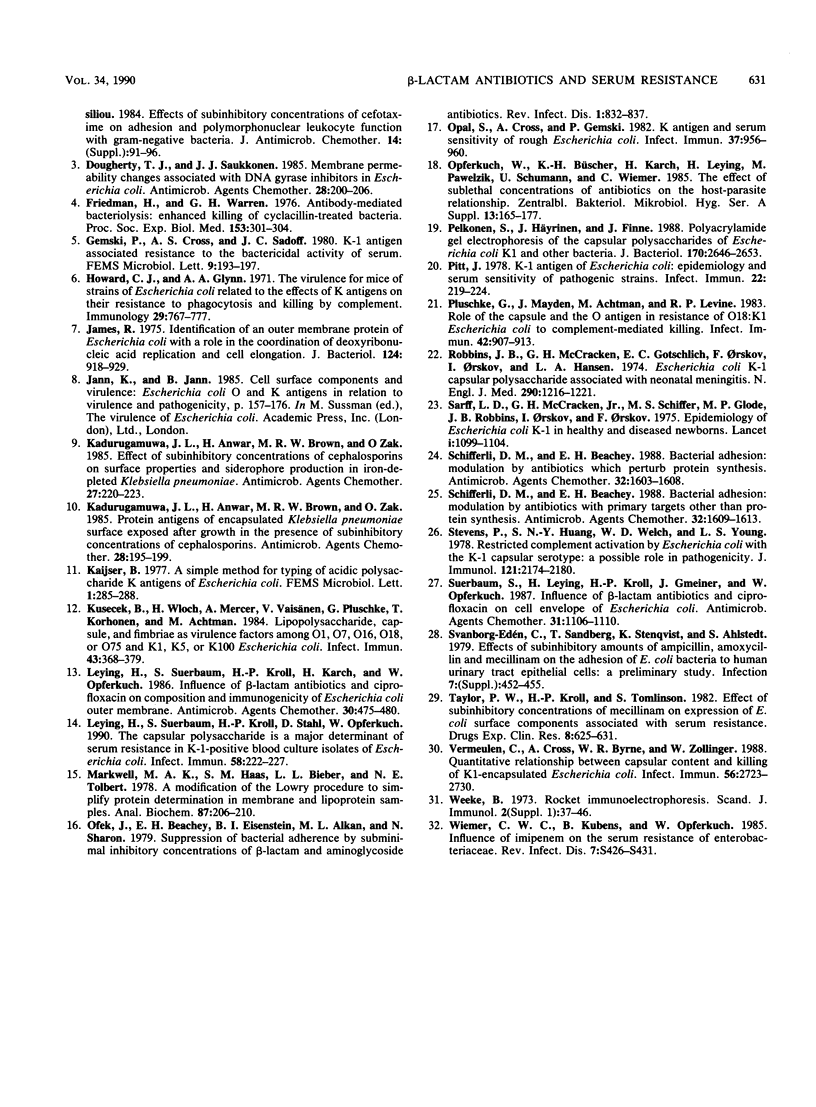Abstract
The K1-positive strains of Escherichia coli are a group with considerable clinical importance, serum resistance being a common virulence factor of these strains. In the present paper, the influences of cephaloridine, imipenem, and ceftazidime on the serum resistance of eight serum-resistant K1-positive E. coli blood culture isolates with smooth-type lipopolysaccharide were studied. All strains were rendered more serum sensitive by treatment with subinhibitory concentrations of antibiotics. The amount of the reduction of serum resistance was dependent on the concentration of the antibiotic. Amounts of K1 produced under the influence of the antibiotics were measured and were found to be reduced for almost all strains tested. To further test the hypothesis that antibiotic-induced reduction of serum resistance is mediated by inhibition of K1 expression, isogenic mutants of one strain were produced by selection for resistance against infection with K1-specific bacteriophages. These mutants were found to be highly serum sensitive. We conclude from this study that beta-lactam antibiotics can render K1-positive serum-resistant strains of E. coli highly serum sensitive and that this effect is mediated by inhibition of K1 expression.
Full text
PDF



Selected References
These references are in PubMed. This may not be the complete list of references from this article.
- BARRY G. T., ABBOTT V., TSAI T. Relationship of colominic acid (poly N-acetylneuraminic acid) to bacteria which contain neuraminic acid. J Gen Microbiol. 1962 Oct;29:335–352. doi: 10.1099/00221287-29-2-335. [DOI] [PubMed] [Google Scholar]
- Dougherty T. J., Saukkonen J. J. Membrane permeability changes associated with DNA gyrase inhibitors in Escherichia coli. Antimicrob Agents Chemother. 1985 Aug;28(2):200–206. doi: 10.1128/aac.28.2.200. [DOI] [PMC free article] [PubMed] [Google Scholar]
- Friedman H., Warren G. H. Antibody-mediated bacteriolysis: enhanced killing of cyclacillin-treated bacteria. Proc Soc Exp Biol Med. 1976 Nov;153(2):301–304. doi: 10.3181/00379727-153-39533. [DOI] [PubMed] [Google Scholar]
- Howard C. J., Glynn A. A. The virulence for mice of strains of Escherichia coli related to the effects of K antigens on their resistance to phagocytosis and killing by complement. Immunology. 1971 May;20(5):767–777. [PMC free article] [PubMed] [Google Scholar]
- James R. Identification of an outer membrane protein of Escherichia coli, with a role in the coordination of deoxyribonucleic acid replication and cell elongation. J Bacteriol. 1975 Nov;124(2):918–929. doi: 10.1128/jb.124.2.918-929.1975. [DOI] [PMC free article] [PubMed] [Google Scholar]
- Kadurugamuwa J. L., Anwar H., Brown M. R., Zak O. Effect of subinhibitory concentrations of cephalosporins on surface properties and siderophore production in iron-depleted Klebsiella pneumoniae. Antimicrob Agents Chemother. 1985 Feb;27(2):220–223. doi: 10.1128/aac.27.2.220. [DOI] [PMC free article] [PubMed] [Google Scholar]
- Kadurugamuwa J. L., Anwar H., Brown M. R., Zak O. Protein antigens of encapsulated Klebsiella pneumoniae surface exposed after growth in the presence of subinhibitory concentrations of cephalosporins. Antimicrob Agents Chemother. 1985 Aug;28(2):195–199. doi: 10.1128/aac.28.2.195. [DOI] [PMC free article] [PubMed] [Google Scholar]
- Kusecek B., Wloch H., Mercer A., Vaisänen V., Pluschke G., Korhonen T., Achtman M. Lipopolysaccharide, capsule, and fimbriae as virulence factors among O1, O7, O16, O18, or O75 and K1, K5, or K100 Escherichia coli. Infect Immun. 1984 Jan;43(1):368–379. doi: 10.1128/iai.43.1.368-379.1984. [DOI] [PMC free article] [PubMed] [Google Scholar]
- Leying H., Suerbaum S., Kroll H. P., Karch H., Opferkuch W. Influence of beta-lactam antibiotics and ciprofloxacin on composition and immunogenicity of Escherichia coli outer membrane. Antimicrob Agents Chemother. 1986 Sep;30(3):475–480. doi: 10.1128/aac.30.3.475. [DOI] [PMC free article] [PubMed] [Google Scholar]
- Leying H., Suerbaum S., Kroll H. P., Stahl D., Opferkuch W. The capsular polysaccharide is a major determinant of serum resistance in K-1-positive blood culture isolates of Escherichia coli. Infect Immun. 1990 Jan;58(1):222–227. doi: 10.1128/iai.58.1.222-227.1990. [DOI] [PMC free article] [PubMed] [Google Scholar]
- Markwell M. A., Haas S. M., Bieber L. L., Tolbert N. E. A modification of the Lowry procedure to simplify protein determination in membrane and lipoprotein samples. Anal Biochem. 1978 Jun 15;87(1):206–210. doi: 10.1016/0003-2697(78)90586-9. [DOI] [PubMed] [Google Scholar]
- Ofek I., Beachey E. H., Eisenstein B. I., Alkan M. L., Sharon N. Suppression of bacterial adherence by subminimal inhibitory concentrations of beta-lactam and aminoglycoside antibiotics. Rev Infect Dis. 1979 Sep-Oct;1(5):832–837. doi: 10.1093/clinids/1.5.832. [DOI] [PubMed] [Google Scholar]
- Opal S., Cross A., Gemski P. K antigen and serum sensitivity of rough Escherichia coli. Infect Immun. 1982 Sep;37(3):956–960. doi: 10.1128/iai.37.3.956-960.1982. [DOI] [PMC free article] [PubMed] [Google Scholar]
- Pelkonen S., Häyrinen J., Finne J. Polyacrylamide gel electrophoresis of the capsular polysaccharides of Escherichia coli K1 and other bacteria. J Bacteriol. 1988 Jun;170(6):2646–2653. doi: 10.1128/jb.170.6.2646-2653.1988. [DOI] [PMC free article] [PubMed] [Google Scholar]
- Pitt J. K-1 antigen of Escherichia coli: epidemiology and serum sensitivity of pathogenic strains. Infect Immun. 1978 Oct;22(1):219–224. doi: 10.1128/iai.22.1.219-224.1978. [DOI] [PMC free article] [PubMed] [Google Scholar]
- Pluschke G., Mayden J., Achtman M., Levine R. P. Role of the capsule and the O antigen in resistance of O18:K1 Escherichia coli to complement-mediated killing. Infect Immun. 1983 Dec;42(3):907–913. doi: 10.1128/iai.42.3.907-913.1983. [DOI] [PMC free article] [PubMed] [Google Scholar]
- Robbins J. B., McCracken G. H., Jr, Gotschlich E. C., Orskov F., Orskov I., Hanson L. A. Escherichia coli K1 capsular polysaccharide associated with neonatal meningitis. N Engl J Med. 1974 May 30;290(22):1216–1220. doi: 10.1056/NEJM197405302902202. [DOI] [PubMed] [Google Scholar]
- Sarff L. D., McCracken G. H., Schiffer M. S., Glode M. P., Robbins J. B., Orskov I., Orskov F. Epidemiology of Escherichia coli K1 in healthy and diseased newborns. Lancet. 1975 May 17;1(7916):1099–1104. doi: 10.1016/s0140-6736(75)92496-4. [DOI] [PubMed] [Google Scholar]
- Schifferli D. M., Beachey E. H. Bacterial adhesion: modulation by antibiotics which perturb protein synthesis. Antimicrob Agents Chemother. 1988 Nov;32(11):1603–1608. doi: 10.1128/aac.32.11.1603. [DOI] [PMC free article] [PubMed] [Google Scholar]
- Schifferli D. M., Beachey E. H. Bacterial adhesion: modulation by antibiotics with primary targets other than protein synthesis. Antimicrob Agents Chemother. 1988 Nov;32(11):1609–1613. doi: 10.1128/aac.32.11.1609. [DOI] [PMC free article] [PubMed] [Google Scholar]
- Stevens P., Huang S. N., Welch W. D., Young L. S. Restricted complement activation by Escherichia coli with the K-1 capsular serotype: a possible role in pathogenicity. J Immunol. 1978 Dec;121(6):2174–2180. [PubMed] [Google Scholar]
- Suerbaum S., Leying H., Kroll H. P., Gmeiner J., Opferkuch W. Influence of beta-lactam antibiotics and ciprofloxacin on cell envelope of Escherichia coli. Antimicrob Agents Chemother. 1987 Jul;31(7):1106–1110. doi: 10.1128/aac.31.7.1106. [DOI] [PMC free article] [PubMed] [Google Scholar]
- Vermeulen C., Cross A., Byrne W. R., Zollinger W. Quantitative relationship between capsular content and killing of K1-encapsulated Escherichia coli. Infect Immun. 1988 Oct;56(10):2723–2730. doi: 10.1128/iai.56.10.2723-2730.1988. [DOI] [PMC free article] [PubMed] [Google Scholar]
- Weeke B. Rocket immunoelectrophoresis. Scand J Immunol Suppl. 1973;1:37–46. doi: 10.1111/j.1365-3083.1973.tb03777.x. [DOI] [PubMed] [Google Scholar]
- Wiemer C. W., Kubens B., Opferkuch W. Influence of imipenem on the serum resistance of enterobacteriaceae. Rev Infect Dis. 1985 Jul-Aug;7 (Suppl 3):S426–S431. doi: 10.1093/clinids/7.supplement_3.s426. [DOI] [PubMed] [Google Scholar]


